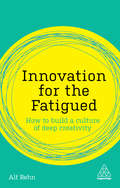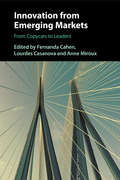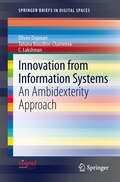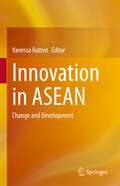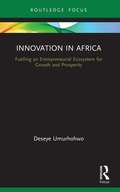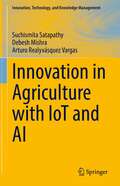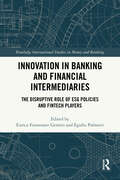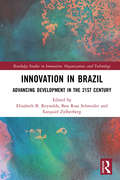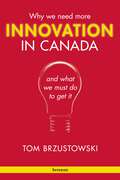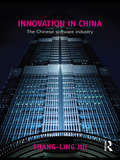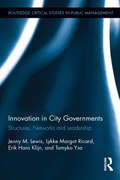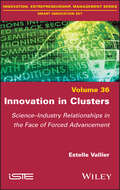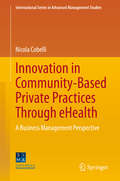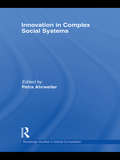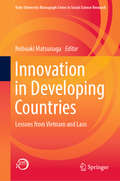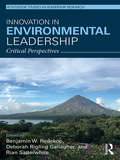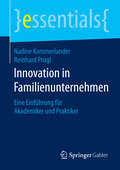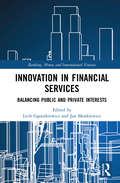- Table View
- List View
Innovation for Systems Information and Decision: Third Innovation for Systems Information and Decision Meeting, INSID 2021, Virtual Event, December 1–3, 2021, Proceedings (Lecture Notes in Business Information Processing #435)
by Adiel Teixeira de Almeida Danielle Costa MoraisThis book constitutes the refereed proceedings of the Third International Meeting on Innovation for Systems Information and Decision, INSID 2021, which was held during December 1-3, 2021. The conference was initially planned to take place in Recife, Brazil, but changed to a virtual meeting due to the COVID-19 pandemic. The 9 full papers presented in this volume were carefully reviewed and selected from a total of 76 submissions. They reflect methodological improvements and advances in multi-criteria decision-making/multi-criteria decision-aid (MCDM/MCDA) oriented toward real-world applications, which contribute to the understanding of relevant developments of current research on and future trends of innovation for systems information and decision.
Innovation for the Fatigued: How to Build a Culture of Deep Creativity (Kogan Page Inspire Ser.)
by Alf RehnHow many presentations on innovation have there been recently? Thousands? Millions? We are experiencing 'innovation fatigue': we feel cheated by the endless rounds of consultants who come into our organizations, deliver conceptual models that don't stick with the realities of business and then leave again. Companies and teams are left feeling more deflated than before, and with not one idea that's impacted the bottom line. Innovation for the Fatigued argues it is worth fighting for the concept and study of innovation in organizations.Business leaders are always looking over their shoulders for the next Uber moment to overtake them, and they recognize that innovation needs to be a top priority. But how does one innovate? This book is the antidote to the empty promises that pervade the innovation industry. By designing a company culture that nurtures ideas, but also defends against incrementalism and fads, we can rediscover the powerful basics of imagination, empathy, play and courage, which are all instrumental in delivering real impactful innovation. Innovation for the Fatigued will detail where companies have got innovation wrong, whilst celebrating and studying the ones that lead the way. With unique, relatable and varied examples, renowned innovation and creativity professor Alf Rehn provides a practical model for getting innovation back on track, and instilling change at speed with real concern for market demands.
Innovation for the Masses: How to Share the Benefits of the High-Tech Economy
by Neil LeeAn engaging, solutions-oriented look at how cities and nations can better navigate issues of innovation and inequality. From San Francisco to Shanghai, many of the world's most innovative places are highly unequal, with the benefits going to a small few. Rather than simply asking how we can create more high-tech cities and nations, Innovation for the Masses focuses on places that manage to foster innovation while also delivering the benefits more widely and equally. In this book, economist Neil Lee draws on case studies of Taiwan, Sweden, Austria, and Switzerland to set out how innovation can be successfully balanced toward equity. As high-tech economies around the world suffer from polarized labor markets and political realities that lock in these problems, this book looks beyond the United States to other models of distributing a leading-edge economy. Lee emphasizes the active role of the state in creating frameworks to ensure that benefits are broadly shared, and he reveals that strong policies for innovation and shared prosperity are mutually reinforcing. Ultimately, Innovation for the Masses provides a vital window into alternative models that prioritize equity, the roadblocks these models present, and what other countries can learn from them going forward.
Innovation from Emerging Markets: From Copycats to Leaders
by Lourdes Casanova Fernanda Cahen Anne MirouxIn recent years, emerging markets have come to represent the largest share of global GDP and have made gains in economic development and political influence. In turn, emerging market companies have taken on a new level of importance in driving innovation, local development and global competition. Advancing an integrative view that captures the diversity of innovation among companies in emerging markets, this book highlights the rapid evolution of emerging markets from imitators to innovation leaders. Building upon research conducted by the Emerging Multinational Research Network (EMRN) in collaboration with several universities in North and South America, Europe and China, this rich and expansive collection includes studies of innovation in regions yet to receive focused analysis in the field. The authors also re-examine dominant theories of innovation and capability creation based on a broad range of case studies and research insights. Offering a taxonomy of emerging market innovations, this collection reveals the unique drivers, types, and outcomes of innovation in emerging markets.
Innovation from Information Systems
by Tatiana Bouzdine-Chameeva C. Lakshman Olivier DupouetRelying on the extensive study of a multi-national Company, this work proposes a process view of the way firms balance tensions between exploring new knowledge and exploiting old one. First, ideas are generated throughout the organization. These ideas are funneled towards specific project teams that further develop and refine them. Second, projects are assessed by the top management. Agreed projects are then progressively transformed into exploitable products, following a transformative learning process. We then make propositions regarding the role information systems can play in sustaining this process. Regarding the first phase of the cycle, we will focus on systems that help in sustaining idea generation and in balancing explorative and exploitive projects in the technologies portfolio of the firm. Regarding the second phase, we will look at information systems that could be useful in supporting knowledge transfer and knowledge interpretation across a multi-national company.
Innovation in ASEAN: Change and Development
by Vanessa RattenThis book focuses on innovation in the ASEAN such as Brunei, Indonesia, Malaysia andSingapore to demonstrate that it is contextually different to other geographic regionsdue to the climate, government structure and history. This book shows that innovationdevelops based on cultural and societal conditions.The aim of this book is to focus on how innovation occurs in Brunei, Indonesia,Malaysia and Singapore. Thereby focusing on the unique country elements of eachcountry but also exploring the integrated history of these countries. The book highlightsthese countries together due to Brunei and Singapore previously being part of Malaysiaand the fact that they are in close geographic proximity. In addition, this book statesthat all countries share the same language (Bahasa Indonesia or Malay), which is acommon cultural feature of these countries. In this book chapters focus on differentforms of innovation from social to technological. Thereby offering a holistic perspectiveabout how innovation occurs within and between these countries.
Innovation in Africa: Fuelling an Entrepreneurial Ecosystem for Growth and Prosperity (Routledge Focus on Business and Management)
by Deseye UmurhohwoThis book emphasizes the need for promoting innovation on the African continent. It identifies the roadblocks for entrepreneurs and discusses ways for developing an ecosystem for innovators to pave a way through the barriers and create ground-breaking products and new technologies which meet consumers’ needs in Africa. In order to stimulate innovation in African countries, there is the need for a more appropriate approach for innovation to occur in a context of international openness to knowledge. This book adopts a practical approach, demonstrating how innovation is an important driver of economic growth and competitiveness. It shows that innovation in Africa should be driven by local people, in response to local problems, and that open technology and knowledge sharing are vital to this project. It further explores key enablers such as the discovery of innovative talent, overcoming barriers, building strategic partnerships and promoting innovation across the continent. The book places emphasis on the creation of an innovation ecosystem as a value-creating tool by stakeholders for nation building and growth in Africa. This book will be of interest to researchers, students, international agencies, governments, businesses and individuals interested in the field of innovation and its potentials. It will also be relevant to investors, manufacturers and other stakeholders involved in the economic development of Africa.
Innovation in Agriculture with IoT and AI (Innovation, Technology, and Knowledge Management)
by Arturo Realyvásquez Vargas Suchismita Satapathy Debesh MishraThis book examines different innovations in worldwide agricultural-systems including the applications of artificial intelligence (AI), internet of things (IoT) and features of machine learning (ML) for the benefits of the farm-community. Specifically, it examines the use of agricultural equipment and IoT to reduce physical stress; innovative equipment that measure and reduce mental work load; and innovative techniques to help with employee safety. Featuring case studies and future implications, this book is an excellent guide for academics and researchers in the agri-sector.
Innovation in Architecture: A Path to the Future
by Alan J. Brookes Dominique PooleIn this highly original book, through a series of essays, key architects and engineers in Europe, Australia, and the USA describe the ideas and development behind the innovative technology in their chosen projects, with the emphasis being on the means of production and the links between design and the manufacturing process.
Innovation in Banking and Excessive Loan Growth
by Daniel C. Hardy Alexander F. TiemanA report from the International Monetary Fund.
Innovation in Banking and Financial Intermediaries: The Disruptive Role of ESG Policies and Fintech Players (Routledge International Studies in Money and Banking)
by Egidio Palmieri Enrico Fioravante GerettoThis volume provides a thorough examination of the drivers of recent innovations in the financial sector. The book's distinctive feature lies in its unique integration of two subjects of particular relevance in the fields of finance and banking: Environmental, Social and Governance (ESG) policies and Fintech innovations. This integration provides a comprehensive perspective on their interdependent influence and implications for financial intermediaries and the financial sector.The book offers an analysis of the theoretical and empirical essentials behind these transformations, including empirical analyses of the bank-specific impact of ESG factors on ratings, loan quality and internal control systems. While facilitating broader research regarding sustainable finance and providing essential findings for those hoping to comprehend and implement the aforementioned strategies into practice, the volume showcases the increasing significance of environmental issues in financial decision-making. Finally, the book addresses the way financial technology innovations are causing disruption to so-called "traditional" credit markets and affecting banking stability in general. It offers a comparison of green and brown Fintech, examining their safety and sustainability dimensions, and discuss the trade-off between progress and the need for responsibility.This work serves to bridge a significant gap between theoretical and practical approaches, providing findings and implications for researchers and academics studying finance, technology and sustainability. Through multiple methodologies, the authors explore changes related to ESG and Fintech, facilitating deeper understanding of their operational implications and significance.
Innovation in Branding and Advertising Communication (Routledge Research in Communication Studies)
by Lluís Mas-ManchónThis book addresses innovative and new aspects of branding and advertising communication, by drawing on a broad, interdisciplinary range of theories, methods and techniques– from body image, identity and mental imagery, to self-exposure and LCM4P – intersecting with branding and advertising constructs and practices. The editor combines the perspectives of an international group of scholars to establish new theoretical frameworks and proposes new methodological designs to conduct comprehensive studies in the field. Situated at the intersection between society, communication and psychology, each chapter presents an innovative approach to branding and advertising research. The book explores topics such as social robots, body image in video advertising, brand personality, transmedia personal brands, erotic content in commercial images, and brand fandom communities. Innovation in Advertising and Branding Communication will be a valuable resource for scholars working in the fields of marketing communication, branding and advertising, online communication, sociology, social psychology and linguistics
Innovation in Brazil: Advancing Development in the 21st Century (Routledge Studies in Innovation, Organizations and Technology)
by Ben Ross Schneider Elisabeth B. Reynolds Ezequiel ZylberbergSince the early 2000s, state-led and innovation-focused strategies have characterized the approach to development pursued in countries around the world, such as China, India, and South Korea. Brazil, the largest and most industrialized economy in Latin America, demonstrates both the opportunities and challenges of this approach. Over the course of nearly 20 years, the Brazilian government enacted various policies and programs designed to strengthen the country’s capacity to innovate. It increased spending on science and technology, encouraged greater collaboration between industry and universities, and fostered the creation of new institutions whose primary aim was to facilitate greater private research and development (R&D) spending. In this book, the editors unite a diverse array of empirical contributions around a few key themes, including public policies, institutions and innovation ecosystems, and firms and industries, that collectively make the case for a new, forward-looking innovation agenda aimed at addressing persistent challenges and exploiting emerging opportunities in Brazil. Its conclusions offer valuable lessons for other developing and emerging economies seeking to accelerate innovation and growth in the modern age. With its interdisciplinary and wide-ranging contribution to the study of innovation, as well as attention to broader policy implications, this book will appeal to scholars and professionals alike.
Innovation in Business Education in Emerging Markets
by Ilan Alon John R. Mcintyre Victoria JonesEmerging market economies account for eighty percent of the world's population and some 75% of its trade growth in the foreseeable future, following US Department of Commerce data. This volume provides insights for success in rapidly growing education markets that can be used by educators, administrators, policy makers and planners.
Innovation in Canada: Why We Need More and What We Must Do to Get It
by Thomas BrzustowskiCanada has a prosperity problem because we don t create enough wealth. Business as usual is not a solution; we need to create more value in new ways - that s innovation. But beyond innovation to solve our current problems, we must learn how to innovate in new ways to deal with whatever future pressures and opportunities arise from global demographics and climate change. Innovation in Canada demystifies innovation and presents its many aspects in one big picture. The book proposes innovation in both goods and services as the means for increasing the value of what the Canadian economy produces. This will raise our prosperity and show up as improved productivity. Written in plain language and illustrated with corporate data, the book underlines the essential roles of technology, entrepreneurship and commerce. It points out important differences between innovation in established firms and innovation in new ventures, whose time scales are shorter and whose needs are more urgent. Innovation in Canada proposes the elements of a supportive government innovation policy, and it outlines the different design principles for government assistance programs needed to provide effective support to the two different groups of innovative companies.
Innovation in Capitalist Economies: Crises, Challenges and Opportunities (Routledge Frontiers of Political Economy)
by Faruk Ülgen Lyubov KlapkivInnovation is critical to increasing global prosperity and also essential to surviving and overcoming the ongoing challenges of pandemics, wars, climate change, and systemic financial turmoil.At the same time, major corporations seek to transform new knowledge and scientific progress into profitable innovations and to increase their influence over society. But if, as these firms claim, this tremendous innovativeness has a positive long-term effect on our lives, who ultimately pays the price for this development? This edited volume tackles issues related to innovation dynamics of modern capitalist economies, exploring the nature, the effects and the dynamics of innovative behaviour and the social impact of related policies. The first part of the book includes chapters on the selected drivers of innovative changes that driven by companies. The focus is made on organizational and financial determinants of innovations as well as on creative communities and social cooperation in networks that promote creative decisions. The second part is devoted to the innovations that play a role in the creation of added value and new financial solutions that allow companies to keep their vitality under the pressure of multiple events such a pandemic, climate policies, or growing geopolitical risk. Together, the contributors explore the various impacts of innovation on the way we are organizing capitalist economies in the 21st century.This book will be of great interest to readers of the political economy of financial and economic development, innovation, banking and finance studies, economic policy, and economic crises.
Innovation in China: The Chinese Software Industry (Routledge Contemporary China Series)
by Shang-Ling JuiA key question for China, which has for some time been a leading global manufacturing base, is whether China can progress from being a traditional centre of manufacturing to becoming a centre for innovation. In this book, Shang-Ling Jui focuses on China’s software industry and examines the complete innovation value chain of software in its key phases of innovation, standards definition, development and marketing. He argues that, except for software development, these key phases are of high added-value and that without adopting the concept of independent innovation as a guiding ideology, China’s software enterprises – like India’s – would have an uncertain future. In other words, the lack of core competence in the development of China’s software industry might restrain the industry from taking the leading position and drive it towards becoming no more than the software workshop of multinationals over the long term. Shang-Ling Jui contends that China’s software industry should and can possess its own complete innovation value chain. Having worked in China’s software industry for many years, the author provides an inside-out perspective – identifying the strengths and weaknesses of the industry and defining the challenges in China’s transition from "Made in China" to "Innovated in China."
Innovation in City Governments: Structures, Networks, and Leadership (Routledge Critical Studies in Public Management)
by Erik Hans Klijn Jenny M. Lewis Lykke Margot Ricard Tamyko Ysa FiguerasInnovation has become an important focus for governments around the world over the last decade, with greater pressure on governments to do more with less, and expanding community expectations. Some are now calling this ‘social innovation’ – innovation that is related to creating new services that have value for stakeholders (such as citizens) in terms of the social and political outcomes they produce. Innovation in City Governments: Structures, Networks, and Leadership establishes an analytical framework of innovation capacity based on three dimensions: Structure - national governance and traditions, the local socioeconomic context, and the municipal structure Networks – interpersonal connections inside and outside the organization Leadership – the qualities and capabilities of senior individuals within the organization. Each of these are analysed using data from a comparative EU research project in Copenhagen, Barcelona and Rotterdam. The book provides major new insights on how structures, networks and leadership in city governments shape the social innovation capacity of cities. It provides ground-breaking analyses of how governance structures and local socio-economic challenges, are related to the innovations introduced by these cities. The volume maps and analyses the social networks of the three cities and examines boundary spanning within and outside of the cities. It also examines what leadership qualities are important for innovation. Innovation in City Governments: Structures, Networks, and Leadership combines an original analytical approach with comparative empirical work, to generate a novel perspective on the social innovation capacity of cities and is critical reading for academics, students and policy makers alike in the fields of Public Management, Public Administration, Local Government, Policy, Innovation and Leadership.
Innovation in Clusters: Science-Industry Relationships in the Face of Forced Advancement
by Estelle VallierForged at the heart of international political bodies by expert researchers, the innovation cluster concept has been incorporated into most public policies in industrialized countries. Based largely on the ideas behind the success of Silicon Valley, several imitative attempts have been made to geographically group laboratories, companies and training in particular fields in order to generate “synergies” between science and industry. In its first part, Innovation in Clusters analyzes the infatuation with the system of clusters that is integral to innovative policies by analyzing its socio historical context, its revival in management and its worldwide expansion, looking at a French example at a local level. In its second part, the book explores a specialized biotechnology cluster dating back to the end of the 1990s. The sociological survey conducted twenty years later sheds a different light on the dynamics and relationships between laboratories and companies, contradicting the commonly held belief that innovation is made possible by geographical proximity.
Innovation in Community-Based Private Practices Through eHealth: A Business Management Perspective (International Series in Advanced Management Studies)
by Nicola CobelliThere are many definitions of eHealth and no consensus around the underlying idea. Most contributions on eHealth focus on informatic, public health, legal, social and anthropological implications. This book investigates eHealth through community-based private practices such as pharmacies, hearing centres, opticians, and private medical centres from a management perspective. It first presents a systematic review of the theoretical research models that have been developed on eHealth. It then identifies the many innovative managerial implications of eHealth, and finally, it analyses reasons why some eHealth tools are or are not adopted.
Innovation in Complex Social Systems (Routledge Studies In Global Competition Ser. #49)
by Petra AhrweilerInnovation is the creation of new, technologically feasible, commercially realisable products and processes and, if things go right, it emerges from the ongoing interaction of innovative organisations such as universities, research institutes, firms, government agencies and venture capitalists. Innovation in Complex Social Systems uses a "hard science" approach to examine innovation in a new way. Its contributors come from a wide variety of backgrounds, including social and natural sciences, computer science, and mathematics. Using cutting-edge methodology, they deal with the complex aspects of socio-economic innovation processes. Its approach opens up a new paradigm for innovation research, making innovation understandable and tractable using tools such as computational network analysis and agent-based simulation. This book of new work combines empirical analysis with a discussion of the tools and methods used to successfully investigate innovation from a range of international experts, and will be of interest to postgraduate students and scholars in economics, social science, innovation research and complexity science.
Innovation in Developing Countries: Lessons from Vietnam and Laos (Kobe University Monograph Series in Social Science Research)
by Nobuaki MatsunagaThe main focus of this book is innovation for developing countries: what is the innovation for, what are the current conditions of the innovation, and how to effectively innovate in developing economies. It contains the latest insights and analyses of innovation based on intensive interviews as well as primary and secondary data of manufacturing firms in developing countries, Vietnam and Laos in particular. Innovation requires something new. Integration of deep understanding of innovation and econometric analyses are a “new combination” in this book, which contrasts with other, similar books in the field. This new approach may benefit policy makers as well as scholars and firms in poor countries. The main points of the book are summarized as follows: First, for most poor countries “learning innovation” is considered the key to economic growth rather than “leading-edge innovation”, which is a more popular theme in similar books on innovation. Second, an overwhelming majority of innovations currently used in poor countries are developed in advanced countries, so technology transfer and learning from the latter are a fundamental source of innovation in the former. Third, a surprisingly high rate of firms (around 50%) reported that they introduced new or significantly improved products or processes in poor countries, and this high innovation rate is a great benefit to be enhanced by government policies. Fourth, the common factors driving innovation of manufacturing firms in Vietnam and Laos are (1) human capital, (2) social capital, and (3) innovation in the past. Fifth, the impact of innovation on firm performance is found to be mixed in these countries. Sixth, so far almost all studies on innovation have focused on product or process innovation, but additional light is shed here on organizational innovation.
Innovation in Environmental Leadership: Critical Perspectives (Routledge Studies in Leadership Research)
by Benjamin W. Redekop Deborah Rigling Gallagher Rian SatterwhiteInnovation in Environmental Leadership offers innovative approaches to leadership from a post-industrial and ecological vantage point. Chapters in this collection are written by leading scholars and practitioners of environmental leadership from around the globe, and are informed by a variety of critical perspectives, including post-heroic approaches, systems thinking, and the emerging insights of Critical Leadership Studies (CLS). By taking the natural environment seriously as a foundational context for leadership, Innovation in Environmental Leadership offers fresh insights and compelling visions of leadership pertinent to 21st century environmental and social challenges. Concepts and understandings of leadership emerged as part of an extractive industrial system; this work asks its readers to re-think what leadership looks like in an ecologically sustainable biological system. This book provides fresh insights and critical perspectives on the vibrant and growing field of environmental leadership. It shows the latest state of knowledge on the topic and will be of interest both to students at an advanced level, academics and reflective practitioners. It addresses the topics with regard to leadership theory and environmental leadership and will be of interest to researchers, academics, and students in the fields of sustainability, environmental ethics, natural resource management, environmental studies, business management, public policy, and environmental management.
Innovation in Familienunternehmen: Eine Einführung für Akademiker und Praktiker (essentials)
by Nadine Kammerlander Reinhard PrüglNadine Kammerlander und Reinhard Prügl geben einen prägnanten Überblick über Innovationen in Familienunternehmen und beleuchten den Innovationsprozess von Familienunternehmen in seinen einzelnen Bestandteilen. Dabei werden die Stärken und Schwächen von Familienunternehmen bezüglich Produkt-, Prozess- und Business Model-Innovationen sowie die Chance für Familienunternehmen, ihren Innovationsprozess zu öffnen (,,Open Innovation") diskutiert. Besondere Bedeutung kommt dabei auch der Nachfolge in Familienunternehmen zu, die unter bestimmten Voraussetzungen erfolgreich mit Wandel und Innovation verbunden werden kann.
Innovation in Financial Services: Balancing Public and Private Interests (Banking, Money and International Finance)
by Jan Monkiewicz Lech G 261 SiorkiewiczThis book delves into the many innovative changes that the financial industry has undergone in recent years. The authors investigate these developments in a holistic manner and from a wide range of perspectives: both public and private, business and consumer, regulators and supervisors. Initially, they set the framework of their analysis by discussing innovation cycles in financial services. Thereafter, they tackle the issue of financial innovations and their consequences for financial stability. They then review the new approaches to financial consumers’ protection, which emerged in the aftermath of the global financial crisis. The authors underline the fact that this new approach is heavily influenced by the recent innovative drive in the financial industry. Next, they switch their attention to the public sector, examining the innovative processes in monetary policy and central banks, structural innovations in the supervisory models and systems, and they assess some specific supervisory challenges regarding blockchain and the application of mathematics in the supervisory capacity. Additionally, the book examines a range of issues related to the private sector, such as recent developments regarding risk transferring mechanisms on the financial market, artificial intelligence and natural language processing for regulatory filings, the development of process management in insurance companies and other innovative products on the market. Finally, Innovation in Financial Services discusses how the digital transformation of the financial system impacts the interaction between the public and private sectors. The book is intended for graduate and postgraduate level students, researchers, public sector officers, as well as financial sector practitioners.

